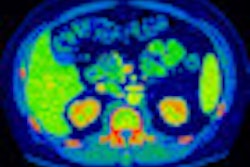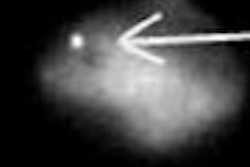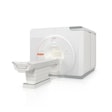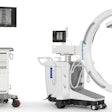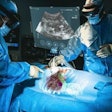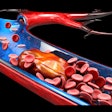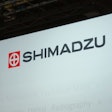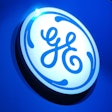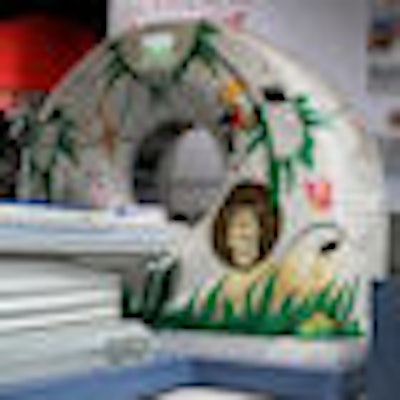
CHICAGO - Its new foray into 3-tesla MRI and new upgrades to its CT technology are among the highlights in the RSNA booth of Toshiba America Medical Systems at this year's conference. The Tustin, CA, company is also touting a new compact ultrasound scanner and new enhancements to its x-ray line.
MRI
Vantage Titan 3T marks Toshiba's foray into the 3-tesla MRI market, building on the company's growth in the 1.5-tesla segment for the past several years. The company is touting the scanner's quiet performance, thanks to its use of Pianissimo vacuum-sealed gradient technology first introduced on the 1.5-tesla Vantage Titan. Pianissimo reduces exam noise by up to 90%, according to the company.
 |
| RSNA attendees peer into the bore of Toshiba's Vantage Titan 3T scanner. |
The scanner sports a wide magnet bore, starting at 71 cm at the edge of the bore to 69 cm in the middle, and gradients rated at an amplitude of 30 millitesla/meter and slew rate of 203 tesla/meter/second. The scanner has a 440-lb standard table limit, with the option of upgrading to a 550-lb limit.
Toshiba is touting its Atlas coil concept, which builds coils into the scanner table so patients don't have to be manually repositioned during scans. Vantage Titan 3T also has an extended table travel feature that enables patients to enter the scanner feet first.
Toshiba has also developed a new interface for the system, called M-Power, designed to make it easier to operate. Vantage Titan 3T is pending U.S. Food and Drug Administration (FDA) 510(k) clearance and is being shown as a work-in-progress.
CT
Toshiba has made pediatric imaging a major focus in its CT division and is demonstrating the utility of its Aquilion One 320-detector-row scanner for pediatric imaging. In its RSNA booth, the company is demonstrating an Aquilion One scanner decorated with decals in a whimsical jungle theme.
Toshiba is also highlighting the utility of its SureExposure Pediatric software, which automatically bases scanning protocols on the size and age of patients. The software ships standard on all Aquilion scanners.
To help calm children scheduled for CT exams, the company has developed a pediatric kit that includes iStation, an audio-visual tool designed to teach kids when to hold their breath during exams, and accessories such as child-size table straps and infant cushions. The company has also signed a relationship with DisplayWorks of Hollywood, CA, which makes small-scale models of Aquilion scanners. Children can play with the models prior to their imaging exams, and Toshiba is making the models available as options with Aquilion One shipments.
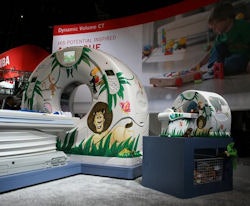 |
| The company is featuring a version of Aquilion One optimized for pediatric use, complete with an optional scale model for children to play with. |
In other CT news, Toshiba has developed what it calls an ultrahelical mode for Aquilion One. The scanner is best known for its ability to perform volume imaging in axial mode with 16 cm of coverage per rotation, but the system can also scan in helical mode. Previously, Aquilion One operated in helical mode at 64 slices per rotation, but Toshiba has upgraded that to 160 detector rows with 8 cm of coverage and a 0.5-mm slice thickness.
Ultrahelical will available on Aquilion One and Aquilion Premium, with commercial release scheduled for the first quarter of 2010. It is pending 510(k) clearance.
A major theme in CT at this year's conference has been iterative reconstruction as a lower-dose alternative to the conventional filtered back projection mode. Toshiba's offering is adaptive iterative dose reconstruction (AIDR), which the company says can reduce dose by 76% for body imaging and 58% for head imaging on Aquilion One in volume mode.
Toshiba plans to deliver AIDR and ultrahelical to customers at no cost.
In other news, the company is showing body perfusion CT and dual-energy scanning as works-in-progress. Body perfusion CT can reduce motion artifacts by registering multiple volumes to an original volume, while Toshiba's application of dual-energy imaging uses kVp and mA switching techniques.
Finally, a Neuro One stroke imaging protocol for Aquilion One includes noncontrast CT, cerebral blood flow analysis, and 4D digital subtraction angiography into a single exam that can perform a full stroke workup in less than five minutes.
Ultrasound
Viamo is a new compact ultrasound scanner first demonstrated at the European Congress of Radiology (ECR) earlier this year and now being shown as a work-in-progress. The system can be operated as a laptop-sized portable system or on a mobile cart.
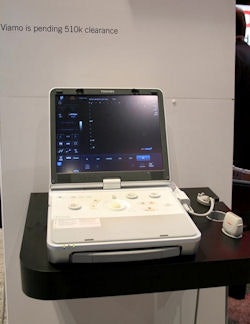 |
| Toshiba is launching the compact Viamo scanner at this year's meeting. |
Viamo is based on Toshiba's flagship Aplio XG scanner, and users can employ many of the same transducers used on the Aplio XG scanner, as well as its own specialized transducers.
Toshiba is positioning Viamo as a radiology ultrasound scanner, and, as such, the system supports many of the company's advanced imaging applications, including ApliPure spatial and frequency compounding technology.
Another new scanner, Aplio MX, is designed to hit a price point between the high-end Aplio XG and economy Xario XG scanners. The scanner is more compact and 32% lighter than Aplio XG and features applications such as elastography, differential tissue harmonic imaging, and ApliPure. Aplio MX is currently shipping.
X-ray
Toshiba's RadRex-i digital radiography system is the highlight in the x-ray section of Toshiba's booth. New developments include a detachable 14 x 17-inch flat-panel detector and the use of a 19-inch monitor rather than the previous 15-inch display. The system's RexView display is mounted on the overhead tube crane, enabling technologists to view images immediately for quality control purposes.
Toshiba is touting the system's ability to handle larger patients, with a 600-lb table weight limit, 600 kilo-heat-unit x-ray tube, and 80-kW generator. All the system's clinical applications are integrated onto a single workstation, including an automated stitching mode available as an option. Toshiba recently made the 100th RadRex-i installation, at Aurora Health Care of Milwaukee, which bought four systems.
In interventional imaging, Toshiba is rolling out a new detector configuration for its Infinix VF-i/BP floor-mounted vascular x-ray system. The unit is now available with a midsized 12 x 12-inch detector in the lateral plane, which offers more flexibility compared to the 8 x 8-inch detector that previously was standard. Toshiba says the 12 x 12-inch lateral detector and 12 x 16-inch frontal-plane detector can achieve steeper angle combinations that offer additional imaging flexibility, with applications in cardiac, neuro, and peripheral imaging.
Finally, CAT-880B is a hybrid catheterization table for the Infinix-i cardiovascular angiography systems. The table offers head-to-toe tilting and side-to-side cradling to meet the needs of both interventional radiologists and surgeons during hybrid interventional procedures.
By Brian Casey
AuntMinnie.com staff writer
November 30, 2009
Related Reading
Toshiba begins refurb equipment program, November 10, 2009
Toshiba delivers Aquilion Premium in U.S. hospital, November 9, 2009
Toshiba touts Aquilion Premium install, November 5, 2009
Toshiba launches new Aplio MX in U.S., November 3, 2009
Toshiba launches ultrasound scanner, October 13, 2009
Copyright © 2009 AuntMinnie.com




